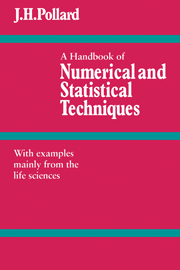Book contents
- Frontmatter
- Contents
- List of statistical and mathematical tables
- Preface
- PART I BASIC NUMERICAL TECHNIQUES
- 1 Introduction
- 2 Errors, mistakes and the arrangement of work
- 3 The real roots of non-linear equations
- 4 Simple methods for smoothing crude data
- 5 The area under a curve
- 6 Finite differences, interpolation and numerical differentiation
- 7 Some other numerical techniques
- PART II BASIC STATISTICAL TECHNIQUES
- PART III THE METHOD OF LEAST SQUARES
- Appendix
- References
- Author index
- Subject index
2 - Errors, mistakes and the arrangement of work
Published online by Cambridge University Press: 18 December 2009
- Frontmatter
- Contents
- List of statistical and mathematical tables
- Preface
- PART I BASIC NUMERICAL TECHNIQUES
- 1 Introduction
- 2 Errors, mistakes and the arrangement of work
- 3 The real roots of non-linear equations
- 4 Simple methods for smoothing crude data
- 5 The area under a curve
- 6 Finite differences, interpolation and numerical differentiation
- 7 Some other numerical techniques
- PART II BASIC STATISTICAL TECHNIQUES
- PART III THE METHOD OF LEAST SQUARES
- Appendix
- References
- Author index
- Subject index
Summary
Summary The result of a numerical calculation may differ from the exact answer because of truncation errors, round-off errors and mistakes. In this chapter, we describe some simple techniques for detecting and reducing truncation and round-off errors. We also suggest ways of avoiding mistakes.
Introduction
The result of numerical calculation may differ from the exact answer to the mathematical problem for one or more of three basic reasons:
The calculation formula may be derived by cutting off an infinite series after a finite number of terms; the errors introduced in this manner are called truncation errors.
A calculating device is only able to retain a certain number of decimal digits and the less significant digits are dropped; errors introduced in this manner are called round-off errors.
Mistakes may be made by man or machine in performing the calculation or recording the result. The word ‘mistake’ is used to distinguish this source of discrepancy due to human or mechanical fallibility from the largely unavoidable ‘errors’ caused by the necessity to truncate an infinite series or the finite capacity of the calculating device.
The research worker must ensure that the final results of a calculation are not rendered useless by errors or mistakes. Intermediate checks are advisable a long calculation.
Further reading: Conte [17] 6–14;Hartree [41] 1–-8; Hildebrand [43] 1–8; Lyon [62] 266–93; Nielsen [73] 2–4; Ralston [84] 1–8.
- Type
- Chapter
- Information
- A Handbook of Numerical and Statistical TechniquesWith Examples Mainly from the Life Sciences, pp. 14 - 17Publisher: Cambridge University PressPrint publication year: 1977



